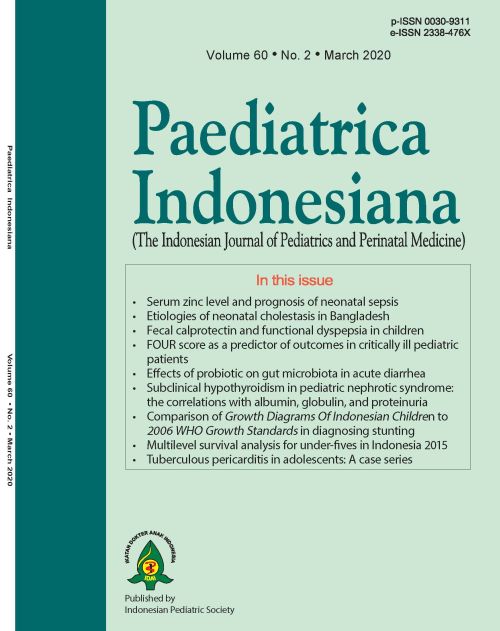Fecal calprotectin and its association with functional dyspepsia in children
Abstract
Background Calprotectin is a calcium-binding protein found normally in small amounts within the digestive tract. Fecal calprotectin measurement is used as a biomarker to identify digestive tract inflammation. Functional dyspepsia is one of the most common health issues in children, occurring in 3-27%, and accounts for considerable quality of life impairment and health care expenses.
Objective To determine fecal calprotectin concentration in generally healthy children as well as to assess for a possible association between fecal calprotectin and functional dyspepsia.
Methods This cross-sectional study was conducted from February to April 2019 in primary school-aged children in Manado, North Sulawesi. Subjects consisted of 38 children aged 6–12 years. Fecal calprotectin was measured in subjects' stool specimens, and considered to be normal if fecal calprotectin concentration of < 50 ?g/g. Diagnosis of functional dyspepsia was defined using the parent-filled Rome IV questionnaire form. Data were analyzed with Chi-square and Phi-coefficient correlation tests.
Results Thirty-eight subjects, 22 boys and 16 girls, were grouped according to fecal calprotectin concentration (normal vs. elevated) and functional dyspepsia diagnosis. Mean fecal calprotectin concentration was 312.45 ?g/g in the functional dyspepsia group and 20.89 ?g/g in the healthy group. Elevated fecal calprotectin was found in 55.6% of the functional dyspepsia group and 10.3% of the healthy group. There was a positive correlation between fecal calprotectin elevation and functional dyspepsia (r=0.471; P=0.004).
Conclusion Current fecal calprotectin physiological cut-off level of 50 ?g/g seems valid for children aged 6-12 years. Elevated fecal calprotectin is associated with functional dyspepsia in children.
References
2. Røseth AG, Fagerhol MK, Aadland E, Schjønsby H. Assessment of the neutrophil dominating protein calprotectin in feces. A methodologic study. Scand J Gastroenterol. 1992;27:793–8. DOI: 10.3109/00365529209011186.
3. Dale I, Fagerhol MK, Naesgaard I. Purification and partial characterization of a highly immunogenic human leukocyte protein, the L1 antigen. Eur J Biochem. 1983;134:1–6. DOI: 10.1111/j.1432-1033.1983.tb07522.x.
4. Steinbakk M, Naess-Andresen CF, Lingaas E, Dale I, Brandtzaeg P, Fagerhol MK. Antimicrobial actions of calcium binding leucocyte L1 protein, calprotectin. Lancet. 1990;336:763–5. DOI: 10.1016/0140-6736(90)93237-j.
5. Brandtzaeg P, Gabrielsen TO, Dale I, Müller F, Steinbakk M, Fagerhol MK. The leucocyte protein L1 (calprotectin): a putative nonspecific defence factor at epithelial surfaces. Adv Exp Med Biol. 1995;371A:201–6. DOI: 10.1007/978-1-4615-1941-6_41.
6. Foell D, Wittkowski H, Vogl T, Roth J. S100 proteins expressed in phagocytes: a novel group of damage-associated molecular pattern molecules. J Leukoc Biol. 2007;81:28–37. DOI: 10.1189/jlb.0306170.
7. Newton RA, Hogg N. The human S100 protein MRP-14 is a novel activator of the beta 2 integrin Mac-1 on neutrophils. J Immunol. 1998;160:1427–35. Print ISSN: 0022-1767, Online ISSN: 1550-6606. PMID: 9570563.
8. Kristensen V, Røseth A, Ahmad T, Skar V, Moum B. Fecal calprotectin: a reliable predictor of mucosal healing after treatment for active ulcerative colitis. Gastroenterol Res Pract. 2017;2017:2098293. DOI: 10.1155/2017/2098293.
9. Mooiweer E, Severs M, Schipper ME, Fidder HH, Siersema PD, Laheij RJF, et al. Low fecal calprotectin predicts sustained clinical remission in inflammatory bowel disease patients: a plea for deep remission. J Crohns Colitis. 2015;9:50–5. DOI: 10.1093/ecco-jcc/jju003.
10. Tibble JA, Sigthorsson G, Foster R, Forgacs I, Bjarnason I. Use of surrogate markers of inflammation and Rome criteria to distinguish organic from nonorganic intestinal disease. Gastroenterology 2002;123:450-60. DOI: 10.1053/gast.2002.34755.
11. Konikoff MR, Denson LA. Role of fecal calprotectin as a biomarker of intestinal inflammation in inflammatory bowel disease. Inflamm Bowel Dis. 2006;12:524–34. DOI: 10.1097/00054725-200606000-00013.
12. Fagerberg UL, Lööf L, Merzoug RD, Hansson LO, Finkel Y. Fecal calprotectin levels in healthy children studied with an improved assay. J Pediatr Gastroenterol Nutr. 2003;37:468–72. DOI: 10.1097/00005176-200310000-00013.
13. Ganesh M, Nurko S. Functional dyspepsia in children. Pediatr Ann. 2014;43:e101-5. DOI:
14. Tibble JA, Bjarnason I. Non-invasive investigation of inflammatory bowel disease. World J Gastroenterol. 2001;7:460–5. DOI: 10.3928/00904481-20140325-12.
15. Palsson OS, Whitehead WE, van Tilburg MA, Chang L, Chey W, Crowell MD, et al. R4PDQ–Child: Parent-report form for Children (4 years and older), in: Rome IV Diagnostic Questionnaires and Tables for Investigators and Clinicians. Gastroenterology. 2016 Feb 13; pii: S0016-5085 (16) 00180-3. DOI: 10.1053/ j.gastro.2016.02.014.
16. Bremner A, Roked S, Robinson R, Phillips I, Beattie M. Faecal calprotectin in children with chronic gastrointestinal symptoms. Acta Paediatr. 2005;94:1855–8. DOI: 10.1111/j.1651-2227.2005.tb01870.x.
Copyright (c) 2020 Jeanette Manoppo, Rizal Somali

This work is licensed under a Creative Commons Attribution-NonCommercial-ShareAlike 4.0 International License.
Authors who publish with this journal agree to the following terms:
Authors retain copyright and grant the journal right of first publication with the work simultaneously licensed under a Creative Commons Attribution License that allows others to share the work with an acknowledgement of the work's authorship and initial publication in this journal.
Authors are able to enter into separate, additional contractual arrangements for the non-exclusive distribution of the journal's published version of the work (e.g., post it to an institutional repository or publish it in a book), with an acknowledgement of its initial publication in this journal.
Accepted 2020-03-04
Published 2020-03-04













